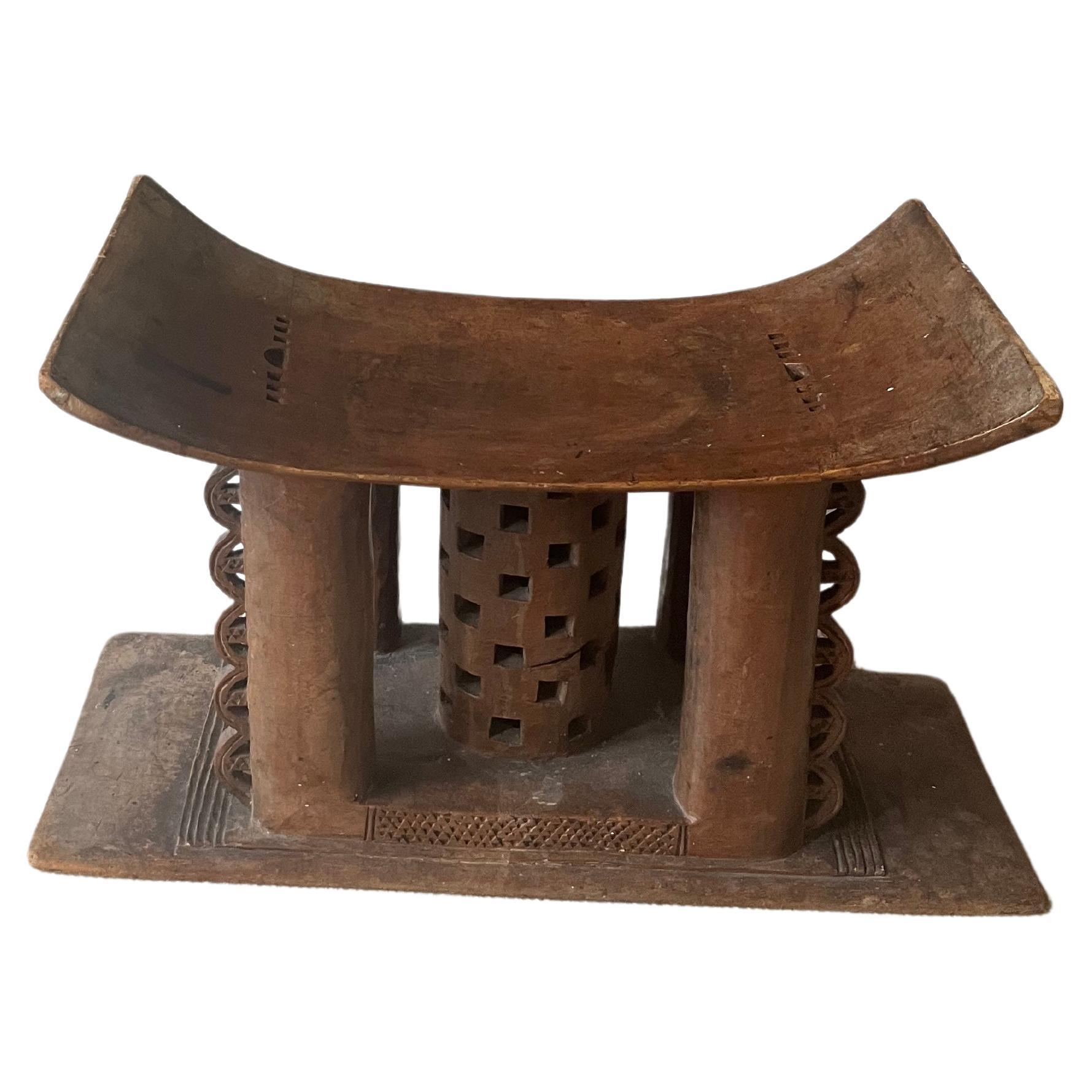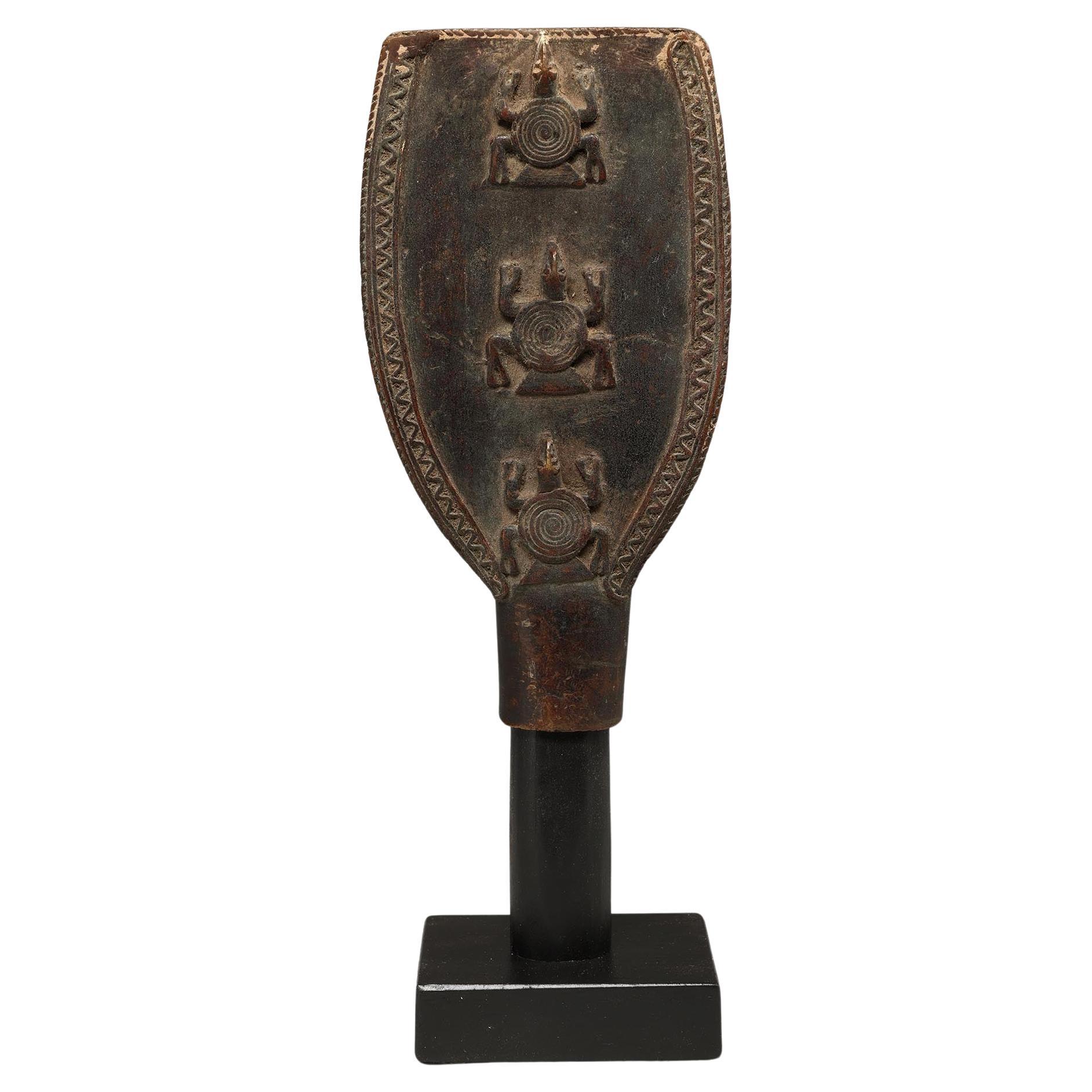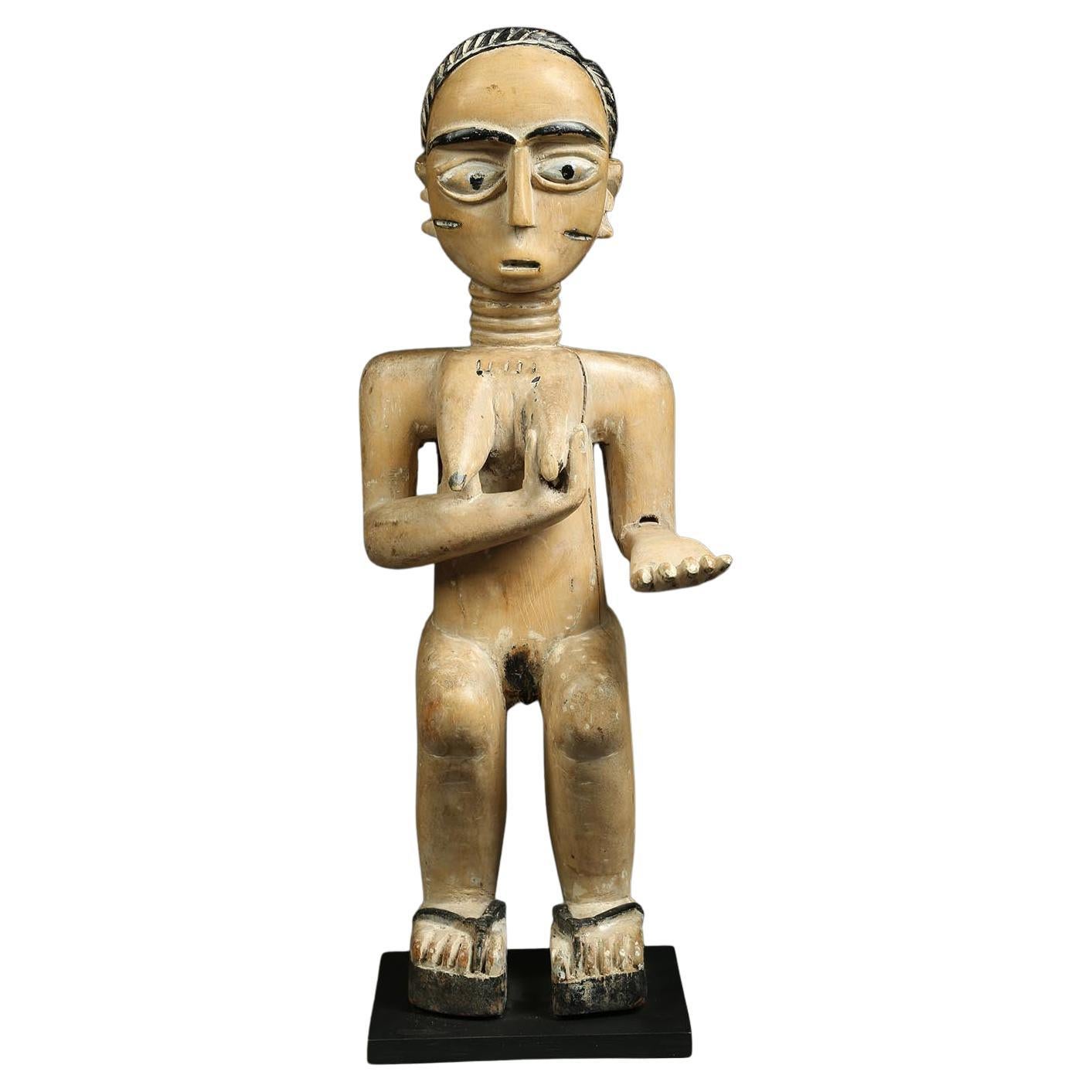Items Similar to Antique Ceremonial Ashanti Ghana African Queens Wooden Stool mmaa dwa
Want more images or videos?
Request additional images or videos from the seller
1 of 12
Antique Ceremonial Ashanti Ghana African Queens Wooden Stool mmaa dwa
About the Item
An antique Ashanti ceremonial stool, carved from a single piece of wood. The up-curved seat stands on five supports, the central one pierced with small semi circles and the outer four supports carved, fretted.
In very good condition
Length 46cm
Height 34cm
Width 24cm
The origin of the Ashante culture can be found in the Akan ethnic groups that inhabited West Africa around Lake Volta and the Gulf of Guinea. The Asante formed a strong confederation that developed from the late 17th century, with the founding of the city of Kumasi, and whose economy was based on trade, gold mining and slave traffic. They are the most important and larger ethnic group in Ghana and was one of the few African states capable of resisting European imperialism.
Within the material heritage and furniture of the Ashante people, some of the most outstanding pieces are the ceremonial stools, being the Golden Stool (Sika Dwa Kofi) the main symbol of the Asante kingdom, which according to tradition, descended from heaven at the end of the 17th century and contains the spirit of their nation. Within the typology of the stools, we find specifically female pieces, the mmaa dwa. These are stools carved from a piece of wood, with a hollow central column and four corner supports, upholding a curved seat. Depending on the status of the owner, the complexity of the design could vary, including carvings.
The stools mmaa dwa have traditionally been associated with women and queen mothers in the various local chiefdoms, being an attribute of their power, as only women can sit on them in public. Oral tradition attributes them symbolic values, such as references to the transmission of power through the queen-mothers. The stool is a symbol of female fertility and propagation and represents queen-mothers as a pillar of her community and family. The link between furniture and owner is very close, becoming identified with his/her soul.
There is an example of this stool in TheRoyal Collection in London presented to Princess Margaret.
- Dimensions:Height: 13.39 in (34 cm)Width: 18.12 in (46 cm)Depth: 9.45 in (24 cm)Seat Height: 12.6 in (32 cm)
- Style:Tribal (Of the Period)
- Materials and Techniques:
- Place of Origin:
- Period:1900-1909
- Date of Manufacture:1900
- Condition:
- Seller Location:London, GB
- Reference Number:1stDibs: LU6578238401992
About the Seller
No Reviews Yet
Vetted Seller
These experienced sellers undergo a comprehensive evaluation by our team of in-house experts.
1stDibs seller since 2022
- ShippingRetrieving quote...Ships From: London, United Kingdom
- Return PolicyA return for this item may be initiated within 14 days of delivery.
More From This SellerView All
- Magnificent Sinhalese Portuguese Kastane Rhino Ceremonial Ceylon Sword 17th CLocated in London, GBA magnificent 17th century Ceremonial Sri Lankan Kastane sword with Rhino handle and gold and silver Portuguese inlayed blade. A kasthane is a short traditional ceremonial or decorative single-edged Sri Lankan sword. The sword is featured in the Flag of Sri Lanka. The main aspect of this Kastane Hilts shows the central monster accompanied by supporting minor iconic forms and the peculiar guard arrangement incorporating Buddhist style Vajra quillons. The scabbard of this Kastane sword is made of Rhino horn and is decorated with brass, silver and gold. It is a testament to the skill of the traditional craftsmen operating in Sri Lankas ancient Royal Sword Workshops. The sword measures 75cm in length The Dutch East India Company (VOC or Vereenigde Oost-indische Compagnie in Dutch) regularly gifted swords to the Kandyan court as part of their strategy to protect their trading privileges. Many of these swords had the traditional Sinhalese decoration but with VOC-marked blades. From 1467 to 1818, Kandy was an independent kingdom in Ceylon—present-day Sri Lanka. In the 18th century, the Kingdom of Kandy was recognized for its outstanding metalwork and craftsmanship. Unfortunately, their fine metalworking came to an end when Kandy fell under British rule in the early 19th century. The kasthane served as symbols of rank and office, presented by the king to noblemen and local chieftains. The silver-mounted kasthane was reserved for the Adigar, the highest officials or feudal lords who also acted as ministers and governors. It also served as a diplomatic gift from the court to European visitors. It was a Sri Lankan tradition to wear the kasthane as a symbol of rank to mark ceremonial occasions. However, the sword type, with an animal-decorated hilt and curved blade, was of European origin. It has its roots in the European hunting swords...Category
Antique 17th Century Sri Lankan Anglo-Indian Antiquities
MaterialsSterling Silver
- Antique Rare Early Portuguese Porto Solid Silver Sterling Tazza 40cm SalverLocated in London, GBA Rare Early Portuguese Solid Silver Sterling Tazza in very good condition, hammered silver. Circular top on a tapering flared based foot. There is an armorial to the middle of the...Category
Antique Early 18th Century Portuguese Rococo Sterling Silver
MaterialsSterling Silver
- Early French Solid Silver Sterling Hip Flask 1835 ParisLocated in London, GBA magnificent solid silver and crystal hip flask with weaved wicker half cover. The cup, colar and cork tipped stopper are all hallmarked. In very good condition. The wicker is also ...Category
Antique Early 19th Century French Louis Philippe Sterling Silver
MaterialsSterling Silver
- Baroque Brazilian Sculpture by Antonio Francisco Lisboa “Aleijadinho” 18th centuLocated in London, GBA very rare Baroque wooden carved sculpture by the Brazilian sculptor Antônio Francisco Lisboa, known as “Aleijadinho” (1738-1814) Original polychrome detailing Circa 1790 Height 1...Category
Antique 18th Century Brazilian Baroque Figurative Sculptures
MaterialsWood
- Max Ackermann Modernist Original Painting Germany 1935 StuttgartLocated in London, GBAn original pastel painting by the German Modernist painter Max Ackermann,(1887 - 1975) He was both painter and graphic artist of abstract works. Signed and dated Born in 1887 in B...Category
Vintage 1930s German Modern Paintings
MaterialsPaper
- Pair Superb Chinese 18th Porcelain Double Peacock Platter Famille Rose QianlongLocated in London, GBA Pair of Chinese famille rose 18th century Porcelain double peacock Platters. Qianlong Hand painted in the classic pattern showing a peacock and peahen perched on rockwork in a garden growing with large, lush peony blooms alongside smaller flowers, the octagonal rims enamelled with floral sprays. Country:China Period :Qianlong (1735-1795) Material: PorcelainDimension: 32.5 cm x 23 cm It is known as the "Peacock service", due to the peacocks on the rocks and also as the "Traveler Service"It is a service known as a "traveller", because it was taken from China to Portugal, and from Portugal to Brazil, when John VI, then Prince of Portugal, alarmed by the Peninsular War...Category
Antique 18th Century Chinese Chinese Export Porcelain
MaterialsPorcelain
You May Also Like
- Ashanti tribal stool GhanaBy Akan AshantiLocated in London, GBAn early to mid 20th century Ashanti tribal stool. An original piece which has been well used and not produced for the tourist industry. Carved from a single piece of wood.Category
Early 20th Century Ghanaian Tribal Tribal Art
MaterialsWood
- Ashanti Bronze Ceremonial Staff Top Hoe with 3 Turtles, GhanaLocated in Point Richmond, CAAshanti cast bronze ceremonial staff top in the shape of a hoe with 3 cast turtles, from Ghana. It is in good condition with a deep patina and polish from traditional use, appropria...Category
Mid-20th Century Ghanaian Tribal Tribal Art
MaterialsBronze
- Ashanti Akan ‘Ghana’ Tribal Standing Female Figure Arm Out AfricaLocated in Point Richmond, CAStanding Akan Ghana female figure, early 20th century, Africa. Intense expression with large eyes. Female figure with one hand on her breast, representing presenting nourishment from...Category
Early 20th Century Ghanaian Tribal Tribal Art
MaterialsWood
- Akan Ceremonial Brass Bronze Lidded Container with Figures Ghana AfricaLocated in Point Richmond, CAFine repousse and cut sheet brass or bronze lidded treasure box from the Akan people of Ghana, West Africa, 20th century. Images include human figures, sandals, swords, and animals. ...Category
Early 20th Century Ghanaian Tribal Tribal Art
MaterialsBrass
- Ashanti Wood Linguist Staff with Bird and Twisted Knots, Ghana 66 inches AfricaLocated in Point Richmond, CACarved painted wood Ashanti Linguist Staff with bird top and twisted knots forms. A staff like this was the symbol of office for the linguist, a traine...Category
Mid-20th Century Ghanaian Tribal Tribal Art
MaterialsWood
- Akan Ceremonial Brass Bronze Plate With Mudfish and Adinkra Symbols Ghana AfricaLocated in Point Richmond, CAFinely worked Akan ceremonial brass plate with hammered designs of a mudfish in center and Adinkra symbols in rim. With wear, some holes in bottom. Field collected in Ghana in 2002....Category
Early 20th Century Ghanaian Tribal Tribal Art
MaterialsBrass





